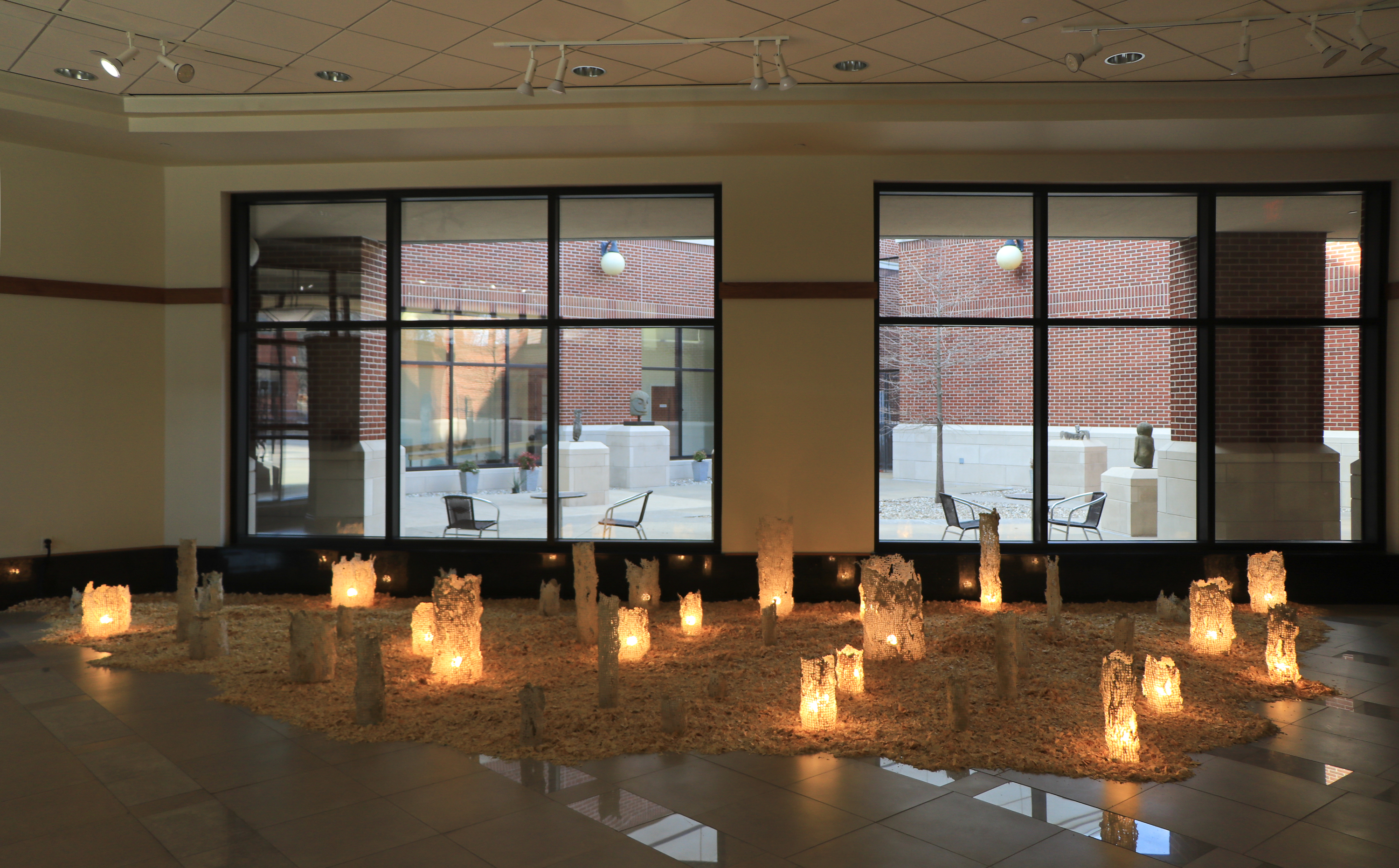Of an Industrial Nature

Of an Industrial Nature brings together highly crafted mixed media artworks representing the impact of industry on the environment and lived experiences of laborers and their surrounding communities. Wall pieces Working Impact, Sturnis Vulgaris, and Industrial Amber surround its main centerpiece is 40 Stumps. The sculptural installation of handmade paper sculptures were arranged in response to the unique architecture of the Pogue Art Gallery at East Central University in Ada, Oklahoma. Of an Industrial Nature follows the histories of humans and the long shadows our industrial activities cast over our shared landscape. On view from January 17-March 14, 2022, the full installation complicates our shared understanding of the past and was reviewed by Art Focus Oklahoma.







40 Stumps (2020-21) represent a ghost forest created from handmade paper forms lit from within. Now a distant memory, the vast forests of the Americas were a natural home to many species and biodiversity. 40 Stumps references the destruction of these forests in the past and present due to the impact of the lumber industry on the natural environment. In 2020, we were confronted with apocalyptic images from forest fires that raced across the western United States as a result of human industry. Climate change compounded with deforestation will lead to further decay of our environment and shared home. This ghost forest comes alive through lights that fade in and out, similar to the summer choruses of frogs or lightning bugs and are made of a combination of processed industrial materials and natural fibers.





Working Impact (2020-21) is a series of 20 unique laser etched woodblock prints made from archival imagery depicting the lumber industry at the turn of the 20th century and the surrounding town’s community from the Lauren Rogers Museum of Art photo archives in Laurel, MS. The chosen images show the diversity of the community through time and the impact of workers on the environment and economics. Multiple histories of labor are shown in the resulting prints. Labor performed by the artist, by the home builder, by the lumber men, by the cook, by the family, by the wood miller, by the salvage man, by the teachers, by the historians, by the photographers, by the mothers, by the archivists, are all brought together into this series including researched texts and archival imagery specific to one former lumber town in Mississippi.




Industrial Amber (2020) consists of 40 sap-like pustules containing a variety of insect life protruding or seeping from the gallery wall. The insects and other creatures suspended in amber-tinted resin came from the artist’s collection of bugs gathered from her home and studio, supplemented by a collection of bugs bartered from a friend. The variety of insects displayed is a record of the biodiversity of our planet that is fading during our planet’s current mass extinction of natural life. It could also represent individuals gathered, yet isolated--similar to pandemic bubbles. Each sap pustule looks as if it were a perfectly clear, fossilized piece of amber. Real amber is made of remnants of resin produced by now extinct coniferous trees. Recreating amber using resin encapsulates the industrial impact of our current actions on the environment and references the yellow pine that fueled the Southern timber industry. The resin transforms insect carcasses into something precious and alluring that seeps from the wall into the viewer’s space.







Sturnus Vulgaris (2021-22) consists of forty European starling feathers cut from artist made paper, pierced through in multiple areas, and embellished with embroidery. The remaining embroidery floss and needle hang from each feather. Colors of blood, umber, dirt and blush, are sewn into each delicate feather. The paper is made from recycled cardboard and US Congressional records from 2016 and is tinted with hues of gray that appear dingy or smoggy. Secured off the wall with needles, the feathers shadows and thread trail into one another and the hanging threads bleed toward the ground. Each feather has been pierced multiple times on a micro scale, small moments of violence that make them more delicate while highlighting the holes like suppurating wounds. Suppurating wounds stubbornly remain open and weeping, much like the legacies of violence wrought on our own bodies, communities, and environment from the longstanding American industries.
